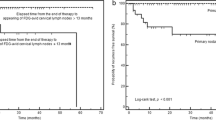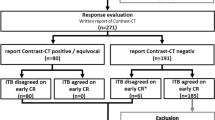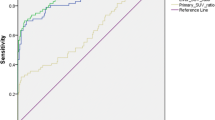Abstract
Background
Reactive cervical lymphadenopathy is common in children and may demonstrate increased 18F–fluoro-deoxyglucose (18F–FDG) uptake on positron emission tomography/computed tomography (PET/CT).
Objective
We sought to evaluate the frequency and significance of 18F–FDG uptake by neck lymph nodes in children with no history of head and neck cancer.
Materials and methods
The charts of 244 patients (114 female, mean age: 10.4 years) with a variety of tumors such as lymphoma and post-transplant lymphoproliferative diseases (PTLD), but no head and neck cancers, who had undergone 18F–FDG PET/CT were reviewed retrospectively. Using the maximum standardized uptake value (SUVmax), increased 18F–FDG uptake by neck lymph nodes was recorded and compared with the final diagnosis based on follow-up studies or biopsy results.
Results
Neck lymph node uptake was identified in 70/244 (28.6%) of the patients. In 38 patients, the lymph nodes were benign. In eight patients, the lymph nodes were malignant (seven PTLD and one lymphoma). In 24 patients, we were not able to confirm the final diagnosis. Seven out of the eight malignant lymph nodes were positive for PTLD. The mean SUVmax was significantly higher in malignant lesions (4.2) compared with benign lesions (2.1) (P = 0.00049).
Conclusion
18F–FDG uptake in neck lymph nodes is common in children and is frequently due to reactive lymph nodes, especially when the SUVmax is <3.2. The frequency of malignant cervical lymph nodes is higher in PTLD patients compared with other groups.



Similar content being viewed by others
Change history
13 December 2017
The original version of this article unfortunately contained a mistake. Author name Alaa Bakkari was incorrect. The correct spelling is given above.
References
Depas G, De Barsy C, Jerusalem G et al (2005) 18F-FDG PET in children with lymphomas. Eur J Nucl Med Mol Imaging 32:31–38
Hudson MM, Krasin MJ, Kaste SC (2004) PET imaging in pediatric Hodgkin's lymphoma. Pediatr Radiol 34:190–198
Ricard F, Cimarelli S, Deshayes E et al (2011) Additional benefit of F-18 FDG PET/CT in the staging and follow-up of pediatric rhabdomyosarcoma. Clin Nucl Med 36:672–677
Tateishi U, Hosono A, Makimoto A et al (2007) Accuracy of 18F fluorodeoxyglucose positron emission tomography/computed tomography in staging of pediatric sarcomas. J Pediatr Hematol Oncol 29:608–612
Uslu L, Donig J, Link M et al (2015) Value of 18F-FDG PET and PET/CT for evaluation of pediatric malignancies. J Nucl Med 56:274–286
Tatsumi M, Miller JH, Wahl RL (2007) 18F-FDG PET/CT in evaluating non-CNS pediatric malignancies. J Nucl Med 48:1923–1931
Lucignani G, Paganelli G, Bombardieri E (2004) The use of standardized uptake values for assessing FDG uptake with PET in oncology: a clinical perspective. Nucl Med Commun 25:651–656
O'Hara SM, Donnelly LF, Coleman RE (1999) Pediatric body applications of FDG PET. AJR Am J Roentgenol 172:1019–1024
Pentenero M, Cistaro A, Brusa M et al (2008) Accuracy of 18F-FDG-PET/CT for staging of oral squamous cell carcinoma. Head Neck 30:1488–1496
Abouzied MM, Crawford ES, Nabi HA (2005) 18F-FDG imaging: pitfalls and artifacts. J Nucl Med Technol 33:145–155 quiz 162-143
Restrepo R, Oneto J, Lopez K et al (2009) Head and neck lymph nodes in children: the spectrum from normal to abnormal. Pediatr Radiol 39:836–846
Shammas A, Lim R, Charron M (2009) Pediatric FDG PET/CT: physiologic uptake, normal variants, and benign conditions. Radiographics 29:1467–1486
Sathiakumar C, Som S, Eberl S et al (2010) NEMA NU 2-2001 performance testing of a Philips Gemini GXL PET/CT scanner. Australas Phys Eng Sci Med 33:199–209
Leung AK, Robson WL (2004) Childhood cervical lymphadenopathy. J Pediatr Health Care 18:3–7
Ludwig BJ, Wang J, Nadgir RN et al (2012) Imaging of cervical lymphadenopathy in children and young adults. AJR Am J Roentgenol 199:1105–1113
Mohseni S, Shojaiefard A, Khorgami Z et al (2014) Peripheral lymphadenopathy: approach and diagnostic tools. Iran J Med Sci 39:158–170
Kojima M, Nakamura S, Shimizu K et al (2005) Reactive lymphoid hyperplasia of the lymph nodes with giant follicles: a clinicopathologic study of 14 Japanese cases, with special reference to Epstein-Barr virus infection. Int J Surg Pathol 13:267–272
Kim JE, Lee EK, Lee JM et al (2014) Kikuchi-Fujimoto disease mimicking malignant lymphoma with 2-[(18)F]fluoro-2-deoxy-D-glucose PET/CT in children. Korean J Pediatr 57:226–231
Curiel R, Akin EA, Beaulieu G et al (2011) PET/CT imaging in systemic lupus erythematosus. Ann N Y Acad Sci 1228:71–80
Fey GL, Jolles PR, Buckley LM et al (2004) 2-deoxy-2-[18F]fluoro-D-glucose positron emission tomography uptake in systemic lupus erythematosus-associated adenopathy. Mol Imaging Biol 6:7–11
Lee DH, Baek HJ, Kook H et al (2014) Clinical value of fine needle aspiration cytology in pediatric cervical lymphadenopathy patients under 12-years-of-age. Int J Pediatr Otorhinolaryngol 78:79–81
Niedzielska G, Kotowski M, Niedzielski A et al (2007) Cervical lymphadenopathy in children--incidence and diagnostic management. Int J Pediatr Otorhinolaryngol 71:51–56
Castelijns JA, Leemans CR (2002) Detection of residual disease of lymph node metastases in the neck, which is treated by (chemo)radiation. AJNR Am J Neuroradiol 23:1618–1619
Curtin HD, Ishwaran H, Mancuso AA et al (1998) Comparison of CT and MR imaging in staging of neck metastases. Radiology 207:123–130
Som PM, Curtin HD, Mancuso AA (1999) An imaging-based classification for the cervical nodes designed as an adjunct to recent clinically based nodal classifications. Arch Otolaryngol Head Neck Surg 125:388–396
Hoang JK, Vanka J, Ludwig BJ et al (2013) Evaluation of cervical lymph nodes in head and neck cancer with CT and MRI: tips, traps, and a systematic approach. AJR Am J Roentgenol 200:W17–W25
Parisi E, Glick M (2005) Cervical lymphadenopathy in the dental patient: a review of clinical approach. Quintessence Int 36:423–436
Connor SE, Olliff JF (2000) Imaging of malignant cervical lymphadenopathy. Dentomaxillofac Radiol 29:133–143
Borhani AA, Hosseinzadeh K, Almusa O et al (2009) Imaging of posttransplantation lymphoproliferative disorder after solid organ transplantation. Radiographics 29:981–1000
Takehana CS, Twist CJ, Mosci C et al (2014) (18)F-FDG PET/CT in the management of patients with post-transplant lymphoproliferative disorder. Nucl Med Commun 35:276–281
Halula SE, Leino DG, Patel MN et al (2015) Isolated upper extremity posttransplant lymphoproliferative disorder in a child. Case Rep Radiol 2015:813989
Marom EM, McAdams HP, Butnor KJ et al (2004) Positron emission tomography with fluoro-2-deoxy-D-glucose (FDG-PET) in the staging of post transplant lymphoproliferative disorder in lung transplant recipients. J Thorac Imaging 19:74–78
Panagiotidis E, Quigley AM, Pencharz D et al (2014) (18)F-fluorodeoxyglucose positron emission tomography/computed tomography in diagnosis of post-transplant lymphoproliferative disorder. Leuk Lymphoma 55:515–519
Vali R, Punnett A, Bajno L et al (2015) The value of (18) F-FDG PET in pediatric patients with post-transplant lymphoproliferative disorder at initial diagnosis. Pediatr Transplant 19:932–939
Author information
Authors and Affiliations
Corresponding author
Ethics declarations
Conflicts of interest
None.
Additional information
A correction to this article is available online at https://doi.org/10.1007/s00247-017-4049-9.
Rights and permissions
About this article
Cite this article
Vali, R., Bakari, A.A., Marie, E. et al. FDG uptake in cervical lymph nodes in children without head and neck cancer. Pediatr Radiol 47, 860–867 (2017). https://doi.org/10.1007/s00247-017-3835-8
Received:
Revised:
Accepted:
Published:
Issue Date:
DOI: https://doi.org/10.1007/s00247-017-3835-8




